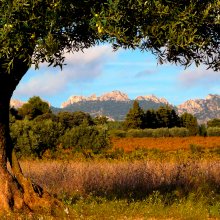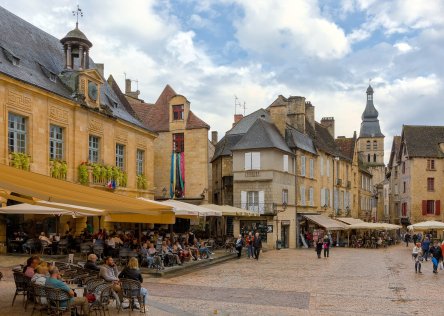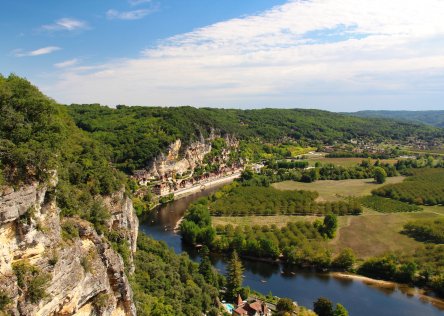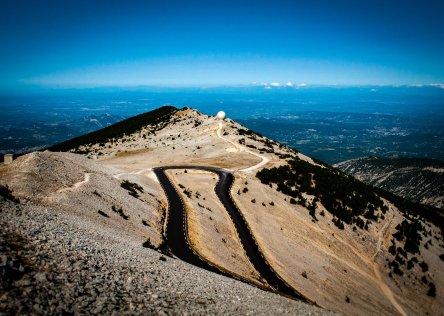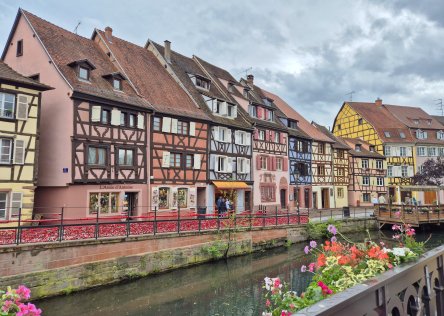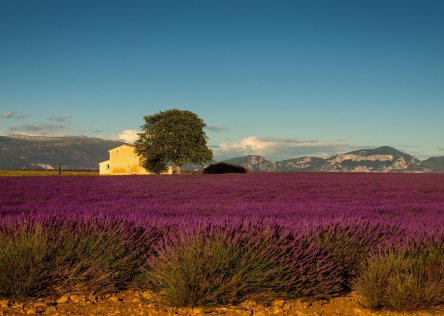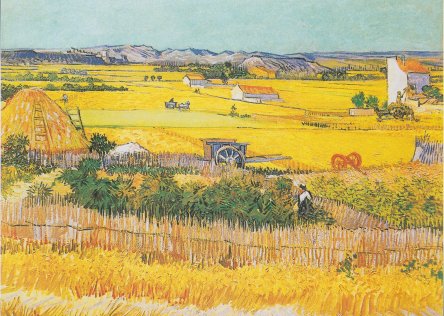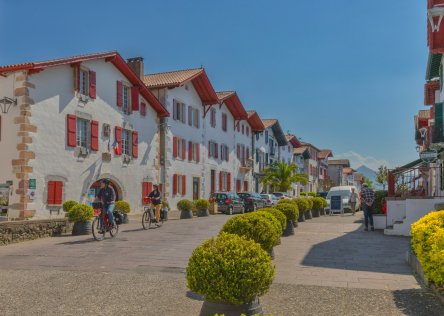We've written this post for people who are looking for inspiration on which French cities to visit and things to do.
Below, we’ve written a short guide of the best things to do and places to visit in each of these French cities:
Aix-en-Provence
Aix-en-Provence, affectionately known as the “City of a Thousand Fountains” (although the number is closer to 100!), captures the essence of Provence with its lively markets, tree-lined avenues, and rich artistic heritage. Once home to painter Paul Cézanne (whose studio you can still visit), Aix is a great place to base yourself if you want to explore other parts of this region on a Provence road trip.
Paul Cézanne’s Art Studio
This is where artist Paul Cézanne created many of his masterpieces. The studio remains exactly as it was during his lifetime, offering visitors an intimate glimpse into his world.
Montagne Sainte-Victoire
This mountain is about 15 miles east of Aix, and inspired many of Cézanne’s paintings. If you enjoy hiking, there are many trails with panoramic views of the beautiful Provence countryside.
Musée Granet
This art museum has a room dedicated to Cézanne, showcasing nine of his oil paintings, and also features pieces from other renowned artists.
Cézanne Trail
This Cézanne walking tour starts from the tourist office and will take you to key sites related to Cézanne’s life, including his home and favorite haunts around Aix-en-Provence.
Cours Mirabeau
Take a leisurely stroll down this famous tree-lined avenue in the heart of Aix-en-Provence. Even though it’s a bit touristy, it’s still a lovely place to sit down for a drink at a café, browse boutiques, or simply people-watch.
Explore Aix’s Old Town
In the charming back streets and hidden squares of the old town, you can escape the tourist crowds and discover the Aix that the locals love.
Aix-en-Provence Markets
Market days in Aix are on Tuesdays, Thursdays, and Saturdays. Whether you want fresh produce, local cheeses and wines, or textiles, handicrafts, and antiques, it’s a great place to experience an important part of Provence culture.
You have the option of staying in beautiful Aix when you book one of our Provence tours
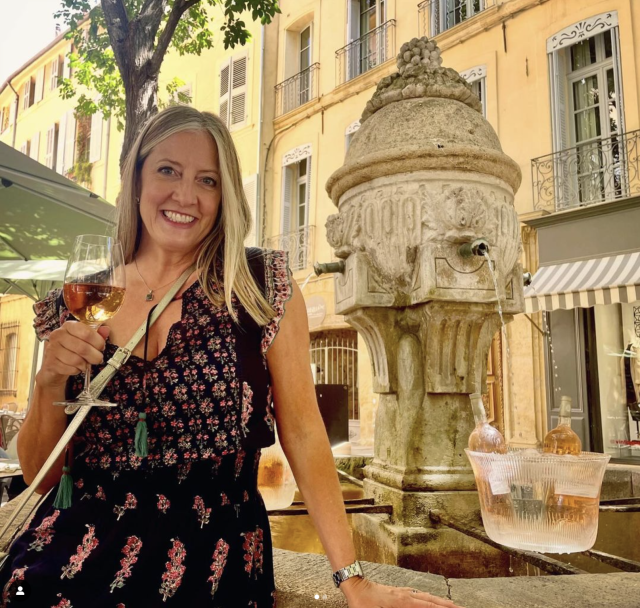
©
Martina & Simon
Avignon, Provence
Avignon, also known as the “City of Popes”, offers a blend of medieval charm and Provençal beauty. With its grand Palais des Papes, ancient stone streets and squares, Avignon is a wonderful place to savor the relaxed pace of the south of France. It’s also a good base if you want to explore Provence. You can get to Avignon easily from Paris by TGV train in around three hours, or fly into Marseille or Nice, which are the closest international airports.
Palais des Papes (Palace of the Popes)
This is the largest Gothic palace in the world, a UNESCO World Heritage site, and the former residence of the popes during the 14th century. The grand halls, frescoes, tapestries, and architecture all tell the story of Avignon’s rich papal history.
Pont d’Avignon (Saint Bénézet Bridge)
This iconic 12th-century bridge once connected the Papal seat to France across the Rhône River. Nowadays, only a portion of the bridge remains, but its historical significance and scenic location make it a must-see.
Notre-Dame-des-Doms Cathedral
Located next to the Palais des Papes at the top of a hill, this Romanesque cathedral, also known as Avignon cathedral, has lovely views of Avignon and contains beautiful chapels and religious artwork.
Petit Palais Museum
Below the Palais des Papes, this museum has an impressive collection of medieval and Renaissance art, including works from Italy and the Avignon School of painters.
Avignon’s Medieval Ramparts
The city’s medieval fortifications still surround much of Avignon and offer a glimpse into the city’s past as a fortified stronghold.
Avignon’s Historic Center
Don’t miss the Place de l’Horloge in Avignon’s old town, the city’s main square, where you can enjoy a coffee or lunch at a local café after exploring the shops.
Avignon’s Markets
Avignon has a variety of markets selling fresh produce, local crafts, and antiques. Les Halles d’Avignon, a covered market in the heart of the city, is a great place to sample Provençal delicacies and buy local specialties like olive oil, cheese, and wine.
Pont du Gard Roman Aqueduct
The Pont du Gard is just a 30-minute drive from Avignon and one of the best-preserved Roman aqueducts in the world. This ancient engineering wonder and UNESCO World Heritage site is popular with our travelers. You can also explore the surrounding park or go kayaking around the bridge along the river Gardon.
Scenic Drive Through Nesque Canyon
If you’re based in Avignon, you can take a scenic drive through the breathtaking Nesque Canyon on your way to the village of Sault. The winding roads and dramatic landscapes make this an unforgettable excursion.
Day Trip to the Luberon Valley
Avignon is a perfect jumping-off point for exploring the stunning Luberon Valley. Drive through picturesque Provençal villages such as Gordes and Roussillon, known for their hilltop views and local markets.
On our tours of Provence, you may also stay in the heart of lovely Avignon, a great jumping off point for exploring the rest of the region.
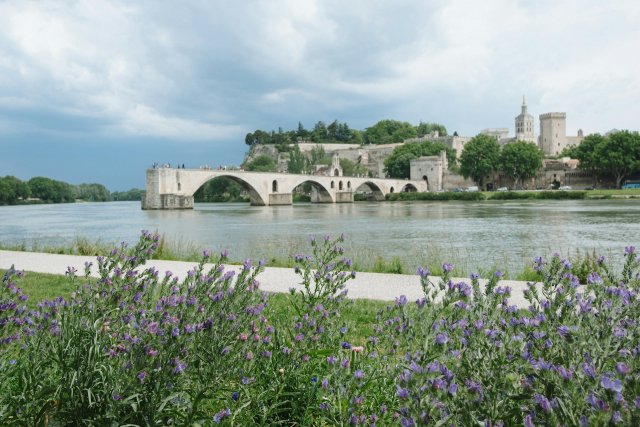
©
Unsplash CC0
Biarritz, Basque Country
Biarritz, a gem on the Basque Coast, blends seaside elegance with the soul of Basque culture. As well as sandy beaches, it also offers great surfing opportunities, and foodies will enjoy digging into the world-renowned Basque cuisine!
Rocher de la Vierge
This famous rock has some lovely views of the Côte des Basques and the Bay of Biarritz. The Virgin statue atop the rock and the bridge designed by Gustave Eiffel make it a must-visit spot. On clear days, you may even see the Pyrenees mountains.
Grande Plage
Biarritz’s main beach is surrounded by elegant buildings, such as the Hôtel du Palais. You may rent a beach chair, take a stroll along the promenade, or watch the surfers catching waves.
Hôtel du Palais
This former palace was once the summer residence of Napoleon III’s wife, Empress Eugénie. Nowadays it’s a luxury hotel. There’s a private chapel nearby built in 1864, with beautiful neo-Mudejar arches and Spanish-style tiles that nod to Empress Eugénie’s Andalusian roots.
Port des Pêcheurs
You can enjoy fresh seafood at one of the local restaurants at this fishing harbor. We recommend trying some delicious pintxos and wine.
La Côte des Basques
This wild beach is perfect for surfing at low tide–in fact it’s one of Europe’s top surfing destinations. You can also enjoy stunning views of the beach from the cliff-top at sunset.
Biarritz Lighthouse
If you’re looking for a beautiful spot to watch the sunset, you could climb the 248 steps of this 19th-century lighthouse at Pointe Saint-Martin, which offers panoramic views of the coast.
Aquarium de Biarritz
At the aquarium, you can learn about the town’s whaling history and explore marine life exhibits, including a shark cave. There are also seal feeding sessions.
Cité de l’Océan et du Surf
If you’re visiting Biarritz with children, Cité de l’Océan et du Surf (Ocean and Surf City) has a fun virtual reality surfing experience and a 3D movie exploring the depths of the ocean.
Église Russe de Biarritz
This 19th-century Russian Orthodox church, built in a neo-Byzantine style, is filled with icons from St. Petersburg, reflecting the city’s Russian aristocratic past.
Casino Municipal
This art deco casino, built in 1929, is a remnant of Biarritz’s glamorous past. If roulette isn’t your thing, you can also visit to admire the architecture, skylights, and mosaics. You may need to present your passport to get in.
Les Halles de Biarritz
Visit this food market to discover and taste local delicacies, from cheeses and meats to fresh oysters. It’s a great spot to stock up for a beach picnic.
We can help you discover Biarritz on one of our Basque Country tours

©
Maureen from Australia
Bordeaux
What a great opportunity to explore the largest urban UNESCO World Heritage site in the world!
You can explore most of Bordeaux city on foot. Collect a map from the Tourist Office on the Esplanade des Quinconces or download the UNESCO Heritage Tour map from the Bordeaux Tourism website. The 3-mile walking tour includes the following places of interest:
Monument aux Girondins
This monument, ‘Liberty Breaking Its Chains, was built between 1895-1901 and sits atop a 43-meter column. It’s in remembrance of the people of Gironde who died in 1789 during the French Revolution.
Wine-tasting at Maison Gobineau
This building houses the Multi Disciplinary Council of Bordeaux Wine - serious business! Enjoy a wine-tasting at the Maison des Vins de Bordeaux. Their famous wine bar has been open since 1788 (just before the French Revolution.
The Grand Théâtre
This stunning building inspired the architect of the Opera Garnier building in Paris. Admire the columns at the entrance, and the 12 stone statues, which include the goddesses Juno, Minerva and Venus.
Notre-Dame Church
This is a gorgeous Dominican baroque church that has featured in a number of television period dramas.
Porte Dijeaux
This site has been a city gateway from the West since Roman times. It was rebuilt in the mid-18th century during the reign of Louis XV, who named it the Dauphin’s gate, after the future heir to the throne, Louis XVI.
La Grosse Cloche
This bell-tower is the only thing that remains of the old town’s 13th century defensive gate. The 7.8-ton bell was cast in 1775.
Shopping on Rue Sainte-Catherine
If you’d like to do some shopping between matches, head for the longest shopping avenue in Europe, Rue Sainte Catherine. The high-end boutiques are at the Place de la Comédie end (also known as the Triangle d’Or or ‘the Golden Triangle).
Food from Marché des Capucins
At the other end of Rue Sainte Catherine is the Place de la Victoire, where you’ll find the Capucins market, Bordeaux’s largest market. You’ll be spoilt for choice, with fresh oysters, dozens of cheeses, charcuterie, fresh fruit, herbs and spices. Choose a few delicacies and then head to the Garonne river for a picnic at the Parc des Sports.
Saint Michel Antiques Market
Antique enthusiasts will enjoy the flea market that takes place on Tuesdays, Thursdays, Fridays and Sundays by the gothic-style Saint Michel Basilica. The Passage Saint Michel is full of galleries, antique stores and second-hand shops. Plus you’ll find some nice vintage offerings in Les Hangars.
Bassins de Lumières, the largest digital art space in the world
You can also immerse yourself in art at les Bassins de Lumières, the world’s largest digital art center. Huge digital images from famous artists are projected onto the walls of this former submarine base. It's quite an extraordinary sight!
Visit Vineyards of St Emilion
The “Bordeaux” wine appellation relates to the geographical area surrounding the city of Bordeaux around 60 miles north, south, east and west. There are also more specific appellations from areas such as Médoc or Saint Emilion, which produce some of the best Bordeaux wines. Book a vineyard or wine-tasting tour - or if you book a tour with France Just For You, we’ll sort it all out for you.
You’ll find more places of interest in Bordeaux on the tourist office’s walking tour map, including the Hôtel Acquart, Saint André cathedral, Place de la Bourse and the Miroir d’Eau (the largest water mirror in the world), to name a few.
Find out more about our self-guided tours that include Bordeaux.
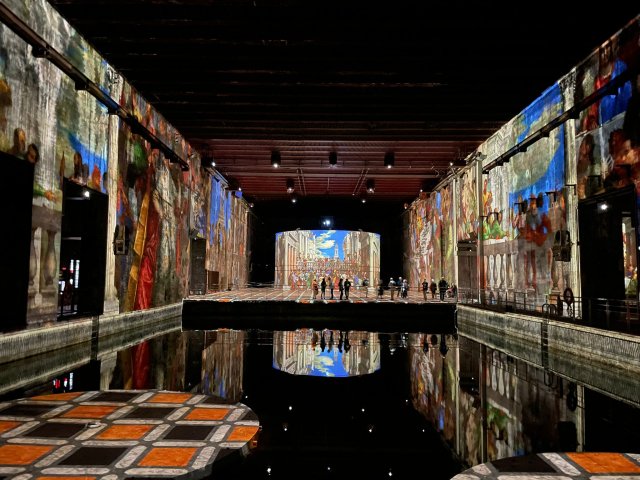
©
France Just For You
Dijon, Burgundy
Known for its rich history, exceptional wines, and hot mustard, Dijon, the capital of France’s Burgundy region, has transformed significantly in recent years. It’s a lively, dynamic city, with a vibrant student population that adds a great energy to the town. In addition, the city’s historic and architectural features have been beautifully restored in the last decades, making Dijon a wonderful destination to explore today.
A Walking Tour of Dijon Following The Owl’s Trail
Follow this well-marked walking trail Le Parcours de la Chouette (The Owl’s Trail) through Dijon, which highlights the city’s key sites, including the famous carved owl on the Church of Notre Dame. Rubbing the owl with your left hand is said to bring good luck!
Church of Notre Dame
This church is a stunning example of French Gothic architecture, dating back to the 13th century. It is famous for its intricate façade, gargoyles and beautiful stained glass windows. It’s also home to the famous Owl of Dijon.
Palais des Ducs de Bourgogne (Ducal Palace)
Here you can explore the former residence of the powerful Dukes of Burgundy, who once rivaled the King of France. The palace houses the Musée des Beaux-Arts, one of France’s oldest museums, which displays art from the medieval to the modern era. You may also tour the grand halls, admire the Gothic and Renaissance architecture, and enjoy panoramic views of Dijon from the Tour Philippe le Bon.
Rue Verrerie
This historic street is known for its medieval façades and antique shops. It’s a lovely place to admire architecture and find some authentic souvenirs.
Maison Millière
This 15th-century building featured in the film Cyrano de Bergerac, and is now a charming bar, tea shop, restaurant, and boutique.
Les Halles Market
Les Halles is a covered market where you can sample local delicacies like jambon persillé. The design of the building is often mistakenly attributed to Gustave Eiffel (architect of the Eiffel Tower), though it was actually designed by Louis-Clément Weinberger.
Mulot et Petitjean
This historic shop on Place Bossuet is the place to taste traditional Dijon pain d’épices (like gingerbread), made by the same family for over 200 years.
Saint Bénigne Cathedral and Abbey
A 13th-century cathedral and abbey, Saint Bénigne is home to the Archeological Museum and one of France’s oldest Christian crypts.
Dijon’s Botanical Gardens
The tranquil botanical garden, Jardin Botanique de l’Arquebuse, is part of the larger Parc de l’Arquebuse, and is lovely to explore on a fine day. It’s also a nice picnic spot if you want a break from the hustle and bustle of the city!
Maille Mustard Shop
The famous Maille mustard shop is *the* place to sample a variety of mustards, and fill a pot with your favorite flavor to take home as a souvenir.
Explore the charming city of Dijon on one of our Burgundy tours
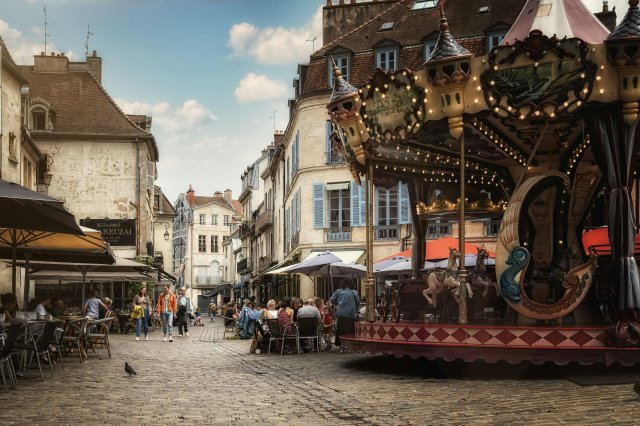
©
Unsplash CC0
Honfleur, Normandy
The best of this gorgeous little harbor town in Normandy can be seen in half a day. You may like to stay a bit longer and relax on Butin beach about a mile and a half from downtown.
Explore the Harbor (Le Vieux Bassin)
The picturesque harbor is famous for its centuries-old buildings and yachts. The changing light throughout the day offers excellent photo opportunities, especially at sunset.
Saint Catherine’s Church
This is the oldest and largest wooden church in France, built by shipwrights in the 15th century. Its impressive wooden interior is reminiscent of an upturned ship’s hull.
Saint Leonard’s Church
This 15th-century church has an impressive late Gothic and Renaissance-style façade, an octagonal bell tower, and a traditional washhouse (lavoir) nearby.
Wander the Old Town
The charming cobbled streets around Saint Catherine’s Church offer art galleries, boutiques, and craft shops. Be sure to stop for some cider and pancakes at a local crêperie–we love Le Cidrerie, hidden down an alley off the Place Hamelin.
Eugène Boudin Museum
Art lovers will enjoy this museum dedicated to Honfleur-born painter Eugène Boudin, who is known for his seascapes and early Impressionist works. The museum also features works by Monet, whom he mentored, and other notable artists.
Maisons Satie
This house-turned-museum is dedicated to avant-garde composer Erik Satie. The interactive exhibits, accompanied by Satie’s music, may be interesting for music fans.
Chapel of Notre Dame de Grâce
Just outside the town, this 17th-century chapel has beautiful views of the Seine estuary and the Normandy Bridge. Inside, you’ll find models of ships and paintings commemorating Honfleur’s maritime history.
Pont de Normandie
This impressive bridge connects Honfleur to the city of Le Havre. The bridge, an engineering marvel, stretches over 1.3 miles across the Seine estuary.
Naturospace
Nature lovers may enjoy this tropical greenhouse filled with exotic plants and over 60 species of butterflies. It’s a peaceful spot for a short walk.
Jardin des Personnalités
This garden features busts of famous French figures such as Monet, Boudin, and Baudelaire. It’s a perfect place for a quiet picnic.
Our travelers love Honfleur. You can visit it on our Normandy tours
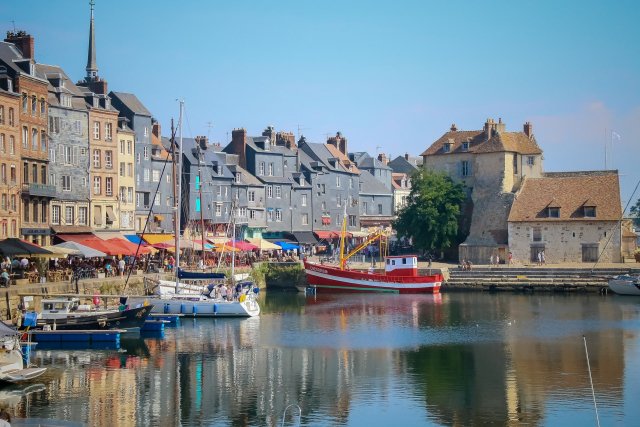
©
Pixabay CC0
Lille
Lille is a beautiful city in northern France. It was Flemish before it was conquered by King Louis XIV in 1667, and this heritage particularly shows through its architecture. Here are a few things you can do if you'll be spending a few days in Lille:
The Old Town of Lille
Like many French cities, its historical center is wonderful to explore, with baroque buildings, cobblestone streets, gabled roofs and pretty facades. You'll see Flemish features in the city's baroque architecture, which dates back to the 1600s and 1700s. There are also plenty of bars in Old Lille, so it's a great place to people-watch during the day or to enjoy a night out.
Palais des Beaux-Arts
Palais des Beaux-Arts is the second largest museum after the Louvre in Paris. You’d need about half a day to see the whole museum, so check the museum website beforehand to find out the latest exhibitions, and choose which parts of the museum you’d like to visit.
You’ll find pieces by Monet, van Gogh, Raphael, Picasso, and Rubens, among many others.
La Vieille Bourse
The old stock exchange building in Lille is one of the most beautiful in the city. A central courtyard is surrounded by 24 renaissance houses with beautiful facades dating back to the 17th century. Nowadays you'll find locals playing chess in the courtyard and a daily book and flower market in the arcades.
Grand Place
Lille’s main square is flanked on all sides by gorgeous gabled buildings. The Théâtre du Nord is housed in the city's former guardhouse dating back to 1717. The more modern buildings in the square have adopted the same Flemish style.
Museum of Modern Art in Lille
See some of the nearly 7,000 pieces of modern art from the 20th and 21 centuries, including masterpieces by Braque, Picasso, Miró, Klee and Modigliani. There's a nice outdoor sculpture park to stroll through too on a nice day.
Birth Place of Charles de Gaulle
The birthplace of former French President Charles de Gaulle is in a leafy suburb to the north of the old town. The 19th century bourgeois home originally belonged to de Gaulle's grandparents. There are some interesting pieces of family memorabilia, including the cradle he once slept in.
Town Hall and Belfry, a UNESCO World Heritage Site
Belfries are a typical Flemish feature, and Lille was Flemish until 1667. The town hall has the highest belfry at 104 meters/341ft and is a UNESCO World Heritage Site. This also makes it a useful point of reference in a city that doesn’t have many high buildings. You can ascend the belfry by elevator or you can take the steps (all 400 of them!).
Marché de Wazemmes
On Tuesday, Thursday and Sunday mornings at the Place Nouvelle Aventure you'll find one of northern France’s most popular and largest outdoor markets. The best but busiest day to visit is on a Sunday, when there are hundreds of stalls. You'll find all kinds of goods, from tasty food, fresh local and exotic fruits and vegetables to clothes and antiques.
If you would like us to plan a customized self-guided tour of the northern France, you can browse our sample tours of Northern France.

©
Alexander D, France Just For You traveler
Lyon
Founded by the Romans in 43 BC, Lyon has a 2,000-year history, world-famous cuisine and impressive architecture. You may admire the Renaissance architecture of old Lyon as you explore on foot, see how the locals shop at the little markets in Croix-Rousse district, and wander through the more contemporary Confluence district.
RELATED: Best time to visit Lyon
Here are some other things you can enjoy in the city while you’re visiting:
Explore the traboules, Lyon’s secret passageways
See if you can find Lyon's famous secret passageways, the 'traboules'! 'Traboule' stems from the Latin word trans ambulare, which means, ‘to pass through’. Many streets in old Lyon run parallel to the river, and this made quick access to fresh water difficult in the past. This is why they built hidden passages connecting adjacent buildings, creating shortcuts through the city.
Canuts (silk workers) also used them to quickly carry silk from their workshops to the merchants by the river, protecting them from wet weather.
There are hundreds of traboules in the old town of Lyon and in the former center of the silk trade, Croix-Rousse. Not all can be accessed by the public, but those that can be are marked by a bronze shield in the old town and a lion's head in Croix-Rousse. If you book a tour with France Just For You, we will help you find them!
Visit Basilica Notre-Dame de Fourvière
This magnificent church in western Lyon, the oldest part of the city was built in the late-19th century. Several Roman sites have also been uncovered in this area. The extravagant interior is worth a look, as is the Museum of Sacred Art. You can also climb the tower to enjoy some great views of Lyon from above.
Colline de Fourvière
There are beautiful views across Lyon from this hill. And while you’re visiting the basilica, you must pay a visit to the Roman ruins nearby. These mark the place where the Romans first settled in Lyon. Every June and July there are live shows and concerts at the Théâtre Gallo Romain de Lyon-Fourvière during the Nuits de Fourvière drama festival. You can see other Roman artefacts at the nearby Gallo-Roman museum.
Parc de la Tête d’Or
North of central Lyon is one of the largest city parks in France. It has a botanical garden with more than 20,000 varieties of plant species and an impressive greenhouse dating back to the 19th century. If you’re traveling with children, they may enjoy a trip to the park’s zoo or a pedal-boat trip on the lake.
Musee Cinéma et Miniature
The Museum of Cinema and Miniaturism is in the old town of Lyon, inside the impressive UNESCO World Heritage and Renaissance building, the Maison des Avocats.
The cinema museum contains hundreds of movie props and artefacts from the last 50 years.
The ‘Miniature’ collection has exhibitions of hyper-realistic miniature scenes, compiled by the best miniaturists in the world. The craftsmanship and minute detail is quite stunning, with recreations of famous places in France or daily life in France across the centuries.
Museum of Fine Arts, Lyon
This is the biggest ‘Musée des Beaux-Arts’ in France after the Louvre, housed in a 17th century former abbey. You’ll find pieces by the world’s most famous artists, including Degas, Renoir, Cézanne, Picasso, El Greco, Canaletto, and Max Ernst, to name just a few. There are also exhibitions displaying Oriental art and 600 artefacts from Ancient Egypt. These include the gates to the Temple of Medamud, which date back to the 3rd century BC.
You may be interested in our self-drive tour of Lyon and eastern France. All of our tours can be customized to include other regions and to accommodate your preferences.
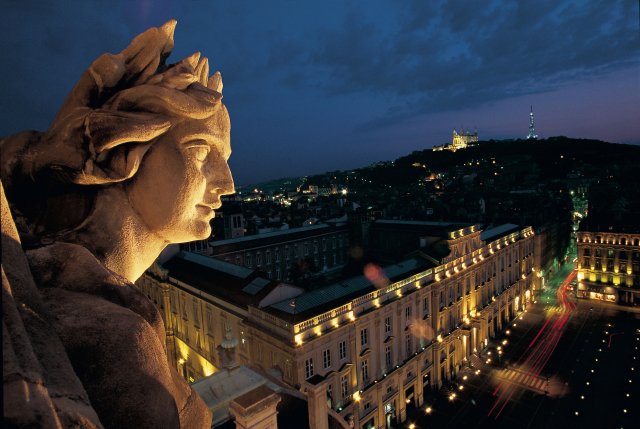
©
T. Deschamps, OT Lyon
Marseille
Marseille is France’s second biggest city and the oldest major city, having been founded by the Greeks from Phocaea in 600 BC. Some of our favorite places in this beautiful city in the south of France include:
Roman Ruins
When the Romans took over Marseille 2,000 years ago, they brought many changes to Provence. You can see some of the ruins at the Museum of the Roman Docks, near the Vieux-Port (Old Port). Or if you’d like to see more impressive and extensive Roman sites, the incredible Pont du Gard Roman aqueduct, Théâtre d’Orange Roman amphitheater in Orange and the Roman Arena in Arles are all within an hour and a half’s drive from the center of Marseille, and are well worth the day trip out of the city.
The Old Port
Much of the city of Marseille revolves around the Vieux Port, so it’s worth taking some time to appreciate it. For millennia, its location in the Mediterranean was central to international trade and migration. You may notice that Marseille’s migrant population has strongly influenced the culture of Marseille across the centuries.
MUCEM Museum
In 2013, Marseille was the European Capital of Culture and opened the Museum of Mediterranean Culture (MUCEM). Unless you’re especially interested in Mediterranean history, a visit to MUCEM isn’t a ‘must’. But the design of the building is impressive, so it’s worth paying it a visit just to admire the architecture.
Up on the roof, there’s a walkway over to a 17th century fortress, Fort Saint Jean, which is worth a look. The museum normally opens at 11am, and is closed on Tuesdays.
Notre Dame de la Garde Cathedral
This is the place to go for great views over Marseille, including the old port. You can take the number 60 bus from the Vieux-Port, or take the long walk up, if you’re feeling energetic!
There have been talks of introducing cable cars up to the cathedral from the old port. Whether these will materialise remains to be seen!
A meal in Port des Goudes
After your self-guided walking tour of Marseille city, you may want to escape the city. We recommend driving to a lovely little village along the coast called Port des Goudes. You can have dinner at one of its waterfront restaurants and enjoy beautiful sunset views against a mountain backdrop. It can get very busy there at weekends and peak times, so keep this one for a weekday.
We love the L’Esplaï du Bar des Goudes restaurant (closed on Wednesdays). Book in advance and ask for a table on the terrace, so you can enjoy views of the marina.
The Beautiful Calanques in Cassis
The creeks or ‘calanques’ to the east of Marseille, around the town of Cassis, are very beautiful. Cassis is a lovely port town and the ideal departure point for boat tours of the calanques. There are also some easy walking routes you can take from Cassis, to three nearby calanques. Check out our post on things to do in Cassis for more details!
Drink Pastis and Eat Bouillabaisse
The favorite aperitif in Marseille is ‘Pastis’ or ‘Ricard’, an aniseed flavored spirit while many locals drink with cold water to cool off.
“Bouillabaisse” is a typical Provençal seafood dish that may be served either as a soup starter or as a main course with a large fish, croutons and “rouille” sauce (made from crushed chilli peppers, garlic, breadcrumbs, and other ingredients blended with stock).
There are often many different varieties of fish included in the dish, so for a main course you can expect to pay 50 to 60 euros per person.
Try some Aïoli sauce
This garlic mayonnaise is delicious served with summer vegetables, salted cod, crispy bread and croutons, mussels, snails, potatoes, or eggs. If you go to a fish restaurant in Marseille, you’ll definitely have a chance to try some! Here we share our own Aioli recipe!
Buy some soap as a souvenir
Marseille is well-known for its soap, so you’ll see many ‘Savon de Marseille’ manufacturers. We don’t recommend buying soap in the city though, because you can’t be sure of its origin. For the best quality and authentic soaps, head to the Marius Fabre soap factory to the north of Marseille.
If you're interested in exploring the south of France, get inspired by our self-guided tour of the south of France.
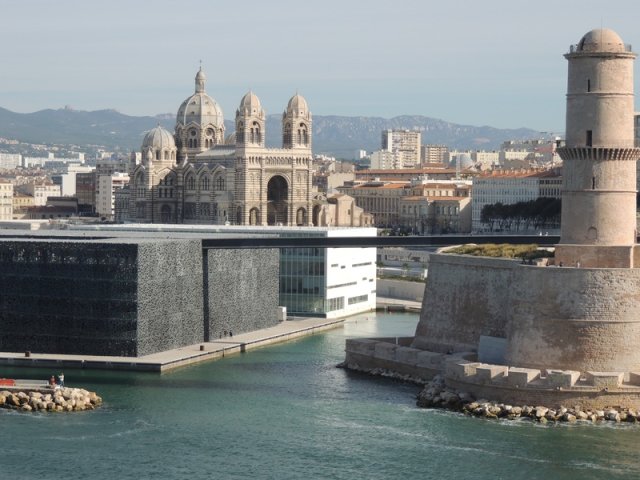
©
Pxhere CC0
Nantes
The city of Nantes lies on the border between Brittany and the Loire. Some of our favorite things to do in Nantes include:
Les Machines de l’île
A great family day out, this ever-growing world of mechanical animals is amazing. It might remind engineering enthusiasts of the mechanical designs of Leonardo da Vinci, or literature lovers of the magical worlds of Jules Verne. The Machines de L'île theme park is a wonderful tribute to the industrial history of the city of Nantes.
While you are there, take a tour on the huge, water-blowing elephant, or take a ride on one of the newer machines, the 35-meter high Heron Tree.
You can also see upcoming projects and new machines that engineers and artists are working on in the gallery.
Jules Verne Museum
The building itself doesn’t have any connection to this famous French writer, but is close to where he was born in 1828. If you’re a fan of Jules Verne’s work, you will enjoy seeing the books, portraits, documents, manuscripts and games in the museum’s galleries, which once belonged to the writer.
Jardin des Plantes
Also known as one of France’s “remarkable gardens”, the seven-hectare botanical garden is in the center of Nantes. The Palm House, a late-19th-century structure made from metal and glass houses plants from the American tropics, while the other three greenhouses have African and Asian orchids on display. As you walk through the gardens, look out for the 220-year-old magnolia tree and 150-year-old sequoias.
Passage Pommeraye
This isn’t just a passage - it’s a gorgeous piece of architecture and luxury shopping arcade dating back to 1843. Admire the neo-renaissance sculpture and stonework, glass roofs that flood the galleries with light - and perhaps do a little shopping.
Château des Ducs de Bretagne
This 13th century castle was occupied by the Dukes of Brittany for 300 years until it was taken over by the French royals in the 16th century. It’s the most western château in the Loire.
It’s free to go into the courtyard and ramparts, and you pay to visit the Nantes history museum. In the museum, you can learn about the city’s evolution, from the times of the slave trade to the time it operated as an industrial port.
The green space by the deep moat is the perfect picnic spot on a nice day.
Cathedrale de Saint-Pierre et Saint-Paul
The construction of Nantes Cathedral started in 1434 and took over 400 years to finish. It’s extravagant gothic design was already well out of fashion by the 1600s but it was kept in order to match the earlier work. Look out for the white marble Tomb of Francis II, Duke of Brittany, considered a masterpiece of the French renaissance from 1507.
Why not browse our sample tours, if you would like to explore the Loire Valley by car while you're in France?
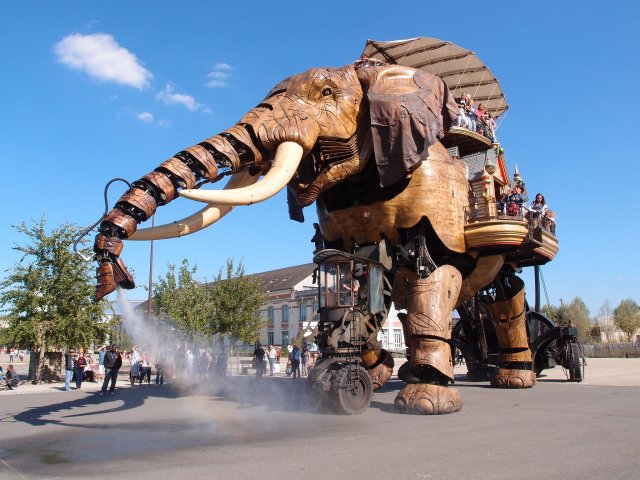
©
Guilhem Vellut - Flickr CC BY 2.0
Nice
Nice is the most popular of the French Riviera cities and can be a good base for exploring the rest of the coast. There's so much to see all along the Cote d’Azur, so we’ll share some of our favorite things to recommend for a French Riviera road trip:
A day at the museum
The French Riviera was a popular vacation spot for the nobility and artists around Europe. Our favorite big art museums in the French Riviera are the Chagall Museum in Nice, or the Picasso Museum in Antibes, not far from Nice.
Fragonard perfume factory, Èze
Just a half-hour drive from Nice, learn how the perfumes from this famous brand are made. If they have workshops running, you might have the opportunity to make your own perfume.
Exotic Botanical Gardens, Èze
A short walk from the perfume factor are the stunning botanical gardens of Èze. There are beautiful views of the Mediterranean and across the hills of the French Riviera.
Hilltop village of Mougins
About 30 minutes’ drive into the hills from Cannes is the lovely village of Mougins. It’s a welcome break from the noisy crowds of the Riviera, with lots of independent art workshops and studios. An ideal opportunity to pick up an authentic arty souvenir from this part of France.
Sainte Marguerite, Lérins islands
If you’d like to enjoy a relaxing day away from the mainland, take a boat from Nice to the Lérins islands, just off the coast of Cannes. Bring a picnic with you and stroll around the island of Sainte Marguerite in a couple of hours. There are lots of easy hiking trails and little creeks.
For a customised tour of Nice and the Cote d'Azur, visit our tours page!
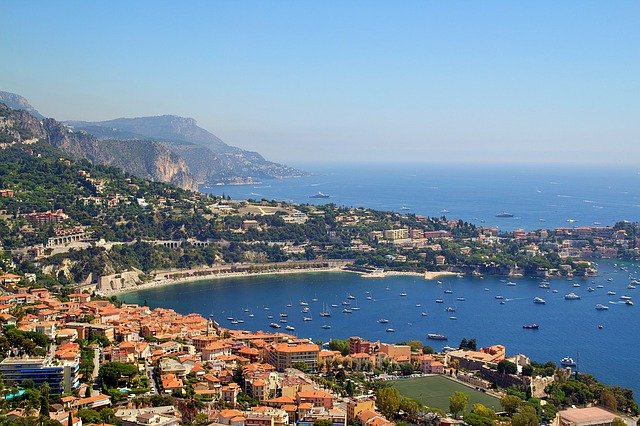
©
Max Pixel CC0
Paris
Here are some of our favorite things to do in the French capital:
Enjoy a day at Paris’s museums
The Atelier des Lumières is a digital art exhibition that projects some of the world's most masterpieces onto the walls of this exhibition space. They’re turned into moving images accompanied by music, so this really is a treat for the senses.
A visit to the Marmottan Monet Museum is a must if you like Claude Monet's work, especially smaller versions of his famous water lilies. You could then follow this with a visit to the Orangerie Museum to see the giant canvases of Monet's water lilies.
If you enjoy both art and visiting gardens, head to the Rodin Museum. Inside the museum you can see some of the works of Auguste Rodin, before taking a stroll through the sculpture garden outside. It's peaceful and the ideal spot for a picnic lunch if the weather permits!
Admire the views over Paris
For impressive 360-degree views of Paris that include the Eiffel Tower, head to the observation deck on the 56th floor of the Montparnasse Tower.
Other places with nice views include Le Georges restaurant at the top of the Centre Pompidou, and the rooftop cafe of the Institut du Monde Arabe.
Discover Paris's neighborhoods
If you’d like to discover any of Paris’s neighborhoods in more depth, we have suggested a self-guided walking tour of Montmartre and have written about our favorite things to see in Le Marais.
Other places of interest in and around Paris include the Paris Catacombs, the Palace of Versailles and its gardens, and Fontainebleau castle.
You may like to browse our sample self-guided tours that include Paris for an idea of how we would plan the ideal itinerary for your trip - just for you!
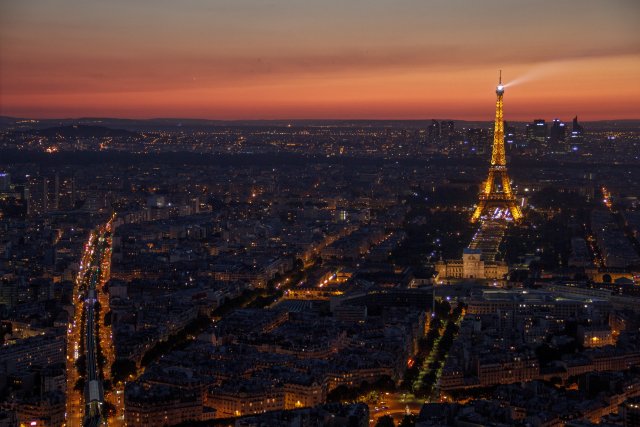
©
Henrique Ferreira Unsplash CC0
Reims, Champagne
As the capital of the Champagne wine region, Reims is a lovely city to explore in a day. While Champagne-tasting will be at the top of most traveler’s lists, the city offers plenty more to discover. Reims’ city center is compact, so you can easily walk between the main sights in a loop of about 4 miles:
Walking Tour of Reims
Discover the city on foot. Places to visit include:
Reims Cathedral
Visit the stunning UNESCO-listed Gothic cathedral where French kings were once crowned. Look out for the stained glass windows by Marc Chagall and the “smiling angel” in the northern portal.
Champagne Tasting at Taittinger or Pommery Cellars
Visit these renowned Champagne houses for a tour of the cellar and an exquisite Champagne tasting.
Villa Demoiselle
Explore the beautiful rooms and gardens of this art nouveau/art deco mansion, with a Champagne tasting at the end.
Musée de la Reddition - Museum of the Surrender
History buffs can visit this former school–now a museum–where Germany signed the unconditional surrender agreement at the end of World War II. The map room is still intact and there are various other war exhibits, including uniforms, war souvenirs, press reports and artifacts from the time. The museum is due to close for renovation work from May 12, 2025 through March 2026.
Les Faux de Verzy
If you’d like to escape the city and take a peaceful stroll among nature, this natural reserve near Reims is home to unique twisted beech trees.
Place Drouet d’Erlon
This pedestrian square, lined with cafés and restaurants, is ideal for relaxing and people-watching over a glass of Champagne.
Maison Fossier
A glass of Champagne is even better when paired with biscuits roses, delicious regional sweets that you can buy from Maison Fossier, an historic bakery. They also make great souvenirs and gifts for loved ones back home.
Café du Palais
Enjoy Champagne and admire the eclectic art collection at this family-run café, which has been open since 1930.
You can visit Reims on any of our Champagne region tours
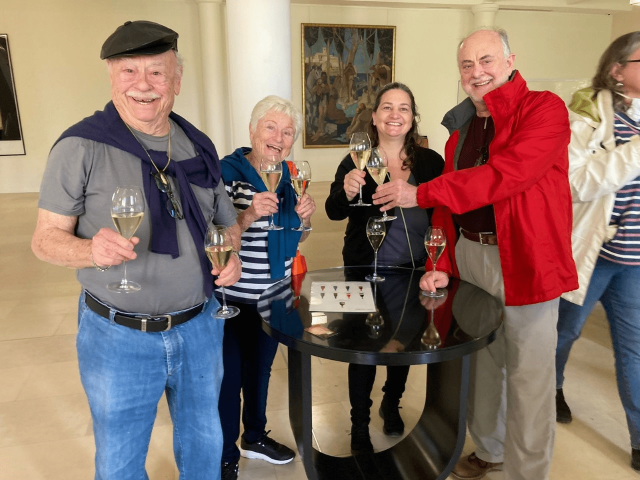
©
Alex & Judy
Saint-Étienne
Saint-Étienne is in east-central France, about an hour’s drive from Lyon. Historically, Saint-Étienne was known for its mining and manufacturing industry. However, in recent years it’s transformed itself into a hub for the creative arts, with many factories now being used as art spaces.
If you’ll be visiting this area or Lyon, you may like to visit:
Musée des Verts
If you're a football/soccer fan, make sure you visit this museum at the Stade Geoffroy Guichard. ‘Les Verts’ are the local team, AS Saint-Étienne (ASSE), who are always in the top half of League 1. In fact, 50 or 60 years ago, they were THE team to beat, having won the French league 9 times in 18 years. You can learn more about the local team’s history in the stadium’s museum, browse their trophies and learn more about the team’s legendary players.
Musée de la Mine
St Etienne has a strong coal-mining history, and you can explore this deeper at the Musée de la Mine, which has preserved the city’s last coal mine. Discover what a day in the life of a 20th-century coal miner would have been like in the reconstructed tunnels. You can also see some of the old mining machinery and buildings.
Musée d'Art et d'Industrie
Learn more about St Etienne’s manufacturing history, including the large-scale production of bicycles in the 19th century. In the gallery dedicated to bicycles, you can see some early prototypes and how the bicycle evolved in time. The city also manufactured weapons, which is why there’s a display of more than 300 guns. There’s also a space dedicated to the textile industry, as the city was well known for its ribbon-making.
Cité du Design
The Manufacture-Plaine-Achille district in St Étienne is dedicated to innovation and the creative industries. The neighbourhood’s showstopper, the Cité du Design, opened in 2009 and is housed in a former weapon factory. The ultramodern building, La Platine, is a sight to behold, and inside you’ll find interesting design exhibitions.
If you're on one of our Lyon tours, you might like to visit Saint-Étienne if you have time
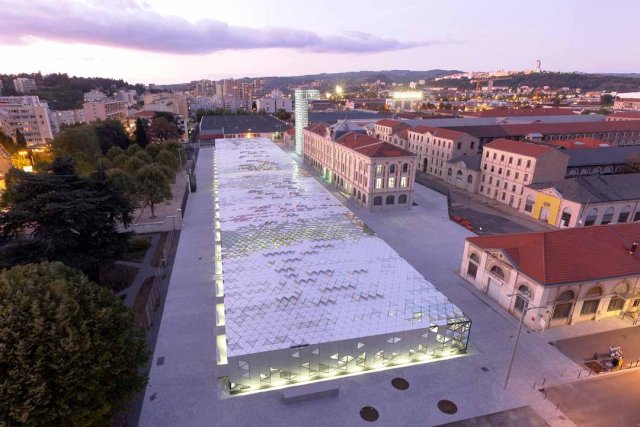
©
Saint-Malo, Brittany
Saint-Malo is located on France’s western coast in Brittany. Once a haven for corsairs, or French privateers, this walled port city is a fascinating place to explore, with its pirate past, Celtic roots, and one of the most beautiful beaches in France (named France’s best beach in 2018). We can help you explore the old town’s cobblestone streets, discover local legends, and enjoy the best of the seaside.
Explore La Ville Intra-Muros (Walled City)
Like many old towns in France, the historic center of Saint Malo is known for its charming cobblestone streets, local shops, cafés, and restaurants.
Saint Vincent’s Cathedral
Inside the walled city, you can visit this beautiful Romanesque and Gothic-style cathedral. It houses the tomb of the famous explorer Jacques Cartier, and its stained glass windows depict scenes from Saint Malo’s history.
Walk Along the Ramparts
The city’s walls stretch for about 2km, with spectacular views of the beaches, harbor, and Rance estuary. You can access the walls from one of the city gates or the castle.
Saint Malo Beaches:
Saint-Malo has some beautiful beaches, including:
Grande Plage du Sillon: Voted France’s best beach in 2018, this stretch of sandy beach is perfect for a scenic walk. It has panoramic views of the walled city and the Fort National, and there are traditional Breton villas with distinctive stone architecture lining the promenade.
Plage de l’Eventail: Popular with families, this beach is located near the Fort National and offers access to the fort at low tide.
Bon Secours Beach: Accessible from the city walls, this beach has a seawater swimming pool and offers kayaking.
Nicet Beach: This more secluded option is ideal for those seeking a quieter spot, though it requires a steep walk to access.
Fort National and Island Fortresses
The Fort National was designed by the famous 17th-century French military engineer, Vauban. It’s accessible at low tide from Eventail Beach. You can also visit Fort du Grand Bé and Fort du Petit Bé, which are both accessible on foot when the tide is out.
La Maison du Québec
Here you can learn about the connection between Saint Malo and Quebec, including the history of Jacques Cartier’s exploration of Canada.
Jacques Cartier Museum
This museum is located in explorer Jacques Cartier’s–who is credited with discovering Canada–former farmhouse, and offers a deeper look into his life and voyages.
The Grand Aquarium
One of the largest aquariums in France, this may be a nice place to visit with children, with its marine life and underwater exhibits.
La Demeure de Corsaire
This is the only surviving home of a former Saint Malo corsair (a type of pirate), offering insight into the city’s privateering history.
Visit the stunning town of Saint-Malo on one of our Brittany tours
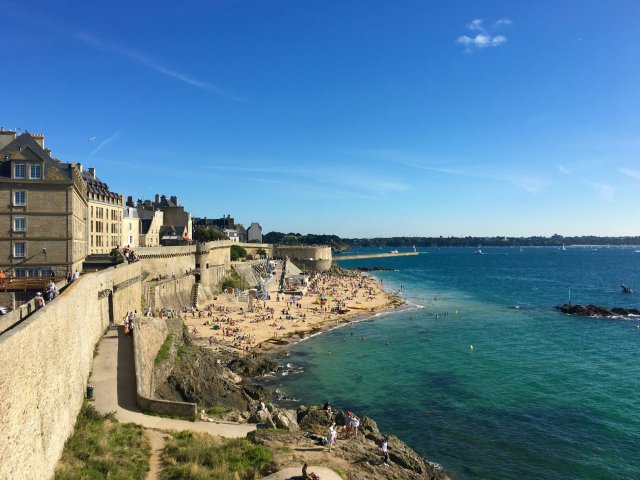
©
Unsplash, CC0
Strasbourg, Alsace
Strasbourg is a blend of old-world charm and modern energy in the Alsace region of eastern France, right on the border with Germany. Its iconic half-timbered houses contrast with the modern structure that houses the European Parliament. Whether you’re exploring the medieval streets or savoring local flavors, Strasbourg is a good starting point for discovering the picturesque villages between Strasbourg and Colmar.
Cathedral Notre Dame de Strasbourg
Strasbourg cathedral is one of the finest examples of Gothic architecture in France. Climb the 332 steps to the top of the spire for views across Strasbourg, the Vosges mountains, and the Black Forest. The medieval astronomical clock inside the spire performs daily at 12:30 p.m.
The Old Town & Petite France
Strasbourg’s historic center is also a UNESCO World Heritage site, and you’ll understand why when you’re strolling between its picturesque half-timbered houses, flower boxes, and the canals in the Petite France district.
Barrage Vauban
This 17th-century dam was built by the military engineer Vauban, and was designed to flood parts of the city in case of attack. It offers a panoramic view of the old town.
European Parliament
If you’re interested in international politics and/or modern architecture, you may enjoy a visit to the European Parliament building. It’s a striking example of contemporary architecture, and you can learn about the European Union in the interactive museum.
Saint Pierre le Jeune Church
An 11th-century church known for its beautiful frescoes, Romanesque bell tower, and cloister. It’s been a place of Protestant worship since 1524.
Winstubs
Winstubs are traditional Alsatian restaurants where you can enjoy local wines, hearty dishes like choucroute (sauerkraut with sausages), and the cozy ambiance that’s typical of this region.
Nearby Alsatian Villages
We warmly recommend that, if you plan to be in Strasbourg for more than a couple of days, you explore some of the beautiful villages nearby. Our favorites include:
Molsheim
A quaint Alsatian village with cobblestone streets and medieval charm. Visit the Place du Marché and the 16th-century La Metzig building.
Rosheim
Known for its medieval walls, gated towers, and the 12th-century Saint Pierre and Saint Paul Church with its ornate sculptures.
Obernai
A picturesque medieval town with a 13th-century tower and Renaissance buildings in the Place du Marché. Don’t miss the Puits à Six Seaux, a beautifully preserved well from 1579.
Mittelbergheim
One of the “most beautiful villages in France,” known for its 17th and 18th-century architecture and scenic trails through the surrounding vineyards.
Andlau
Famous for its bear-related legends, this village features the 9th-century Saints Pierre and Paul Abbey, where a stone bear guards the crypt.
Dambach-la-Ville
Nestled among vineyards, this village features brightly painted half-timbered houses and nearby hiking trails.
Soufflenheim
Known for its traditional Alsatian pottery, Soufflenheim’s artisans create beautiful pieces, including the work of Poterie Lehmann, a family business spanning four generations.
Haut-Koenigsbourg Castle
Visit this medieval castle perched above the Alsatian vineyards. Built in the 12th century and beautifully restored in the late 19th century, it offers a glimpse into the region’s history and panoramic views of the surrounding countryside.
You may visit Strasbourg on one of our Alsace tours
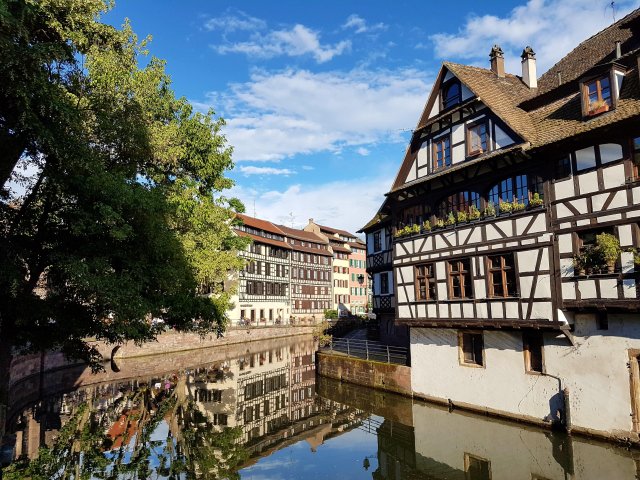
©
Naomi, France Just For You
Toulouse
Also known as ‘La Ville Rose’ (pink city), Toulouse is a university city with a vibrant music scene and a very nice old town.
Canal du Midi and Garonne River
Take a boat trip along the Canal du Midi or the Garonne River and admire the warm pastel colors of the city’s buildings, or go on a self-guided walking tour.
Place du Capitole
In the old town, admire the majestic neoclassical palace containing extravagant ceremonial rooms painted with gorgeous frescoes. Entry is free.
Basilica of Saint Sernin
Then walk north to the beautiful medieval Basilica of Saint Sernin, which is said to contain the relics of 128 saints and a thorn from Jesus's Crown of Thorns.
Japanese Garden
By the Canal du Midi you’ll find the lovely Japanese garden with its traditional red bridge and a large dragon sculpture.
Les Abattoirs art museum
Les Abattoirs art museum is a good option if you’re a fan of art. Check the exhibitions beforehand on the museum’s website.
Enjoy a drink on a cafe terrace
Then finish off by enjoying a drink in one of the old town’s squares - there are plenty of cafés and bars to choose from.
Toulouse is just a short drive from the medieval fortified city of Carcassonne.
We highly recommend a visit to Carcassonne if you have space in your schedule!
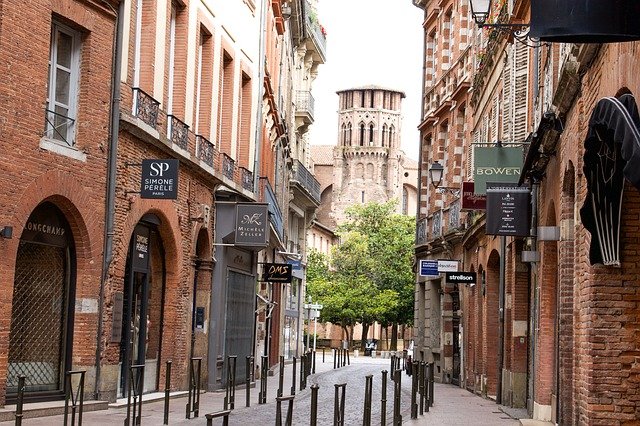
©
Pixabay CC0
Tours, Loire Valley
The gateway to the Loire Valley, Tours is a lively city full of French charm and history. It’s known for its beautiful architecture, typical markets, and welcoming atmosphere, and is a good starting point for a Loire Valley road trip exploring the region's châteaux and vineyards.
Cathédrale Saint-Gatien
This stunning Gothic cathedral is known for its stained glass windows and architecture, including two striking towers.
Cloître de la Psalette
Next to the cathedral, this charming cloister is an architectural gem with beautiful gardens, perfect for a peaceful break from sightseeing.
Place Plumereau
This picturesque square is in the heart of Tours’ old town. Surrounded by half-timbered houses and busy cafés, it’s a pleasant spot to stop, enjoy a drink, and people-watch.
Jardin des Prébendes d’Oé
This is a beautiful English-style garden with ponds, statues, and walking paths–a lovely spot for a peaceful stroll or a picnic.
Basilique Saint-Martin de Tours
Visit this basilica dedicated to Saint Martin, one of France’s most revered saints. The crypt houses the saint’s tomb, and the church is a key pilgrimage site.
Tours Old Town (Le Vieux Tours)
The cobbled streets of the old town are filled with historical buildings, medieval houses, charming shops, and restaurants.
Loire River
Many of our travelers enjoy a scenic walk or bike ride along the banks of the Loire River. If you do a tour with us, we can also arrange for you to do a boat trip in a traditional boat, if you like.
Château de Tours
This historical castle hosts contemporary art exhibitions and offers an insight into Tours’ medieval past.
Les Halles de Tours
You can sample fresh local produce, including cheeses, charcuterie, and wines from the Loire Valley at Tours’ bustling market hall.
Explore the lovely city of Tours on one of our Loire Valley tours
Let Us Plan Your Tour of France
If you would like us to plan a self-guided tour of France for, contact us, Emilie, Laura and Clelia, and we will be more than happy to help!
Alternatively, complete and send us the trip-planning form below!
Send us your France trip-planning form
FAQs
What are the best cities to visit in the French Riviera?
The best French Riviera cities to visit, and some of the larger towns, are: Nice, Monte Carlo, Cannes, Grasse, Antibes, and Menton.
You could also visit the port city of Toulon, which you might find has a more authentic, local feel, as it isn't as touristy.
Technically, Marseille may also be considered part of the French Riviera, but since it's further away, many leave it out of their itinerary or save it for another trip. It is more practical to include in one of our self-drive tours in Provence.


